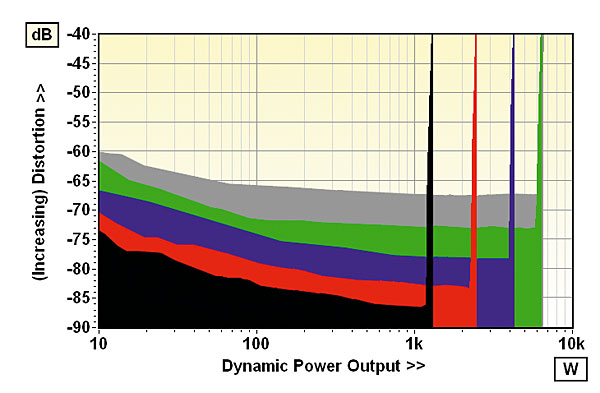Musical Fidelity Tri-Vista kWP and kW Amplifiers Lab Report
Testing an amp, particularly a bridge mode design that rivals an arc-welder, isn't something to be undertaken lightly. One slip during the power tests could prove very costly since metal-bodied resistor loads can explode under extreme conditions. MF's Tri-Vista kW has 'extreme' written all over it. Nevertheless, any trepidation at routing many kilowatts of power through the QC Suite was finally outweighed by my curiosity to explore this amplifier's maximum potential.
The separate PSU includes a pair of 2kW toroidal transformers that feed ±55V to each kW amp. The latter are equipped with 6x100,000µF reservoir capacitors plus MF's proprietary choke regulation to damp down supply ripple (which, if we are guided by the 117dB A-wtd S/N ratio, it clearly does). In effect, there are two independent amps in each monoblock, each comprising ten pairs of devices for each half of the bridged or floating output. Bridged operation allows the amplifier to deliver the 90V-plus required to support a power output in excess of 1kW into 8ohm. Traditionally, bridging is idealised for higher impedance loads as the maximum current output is reduced in line with the increased voltage capability. In this instance, the PSU's stored energy is sufficiently ludicrous to sustain vast outputs into any load.

So how vast is the power and current output? A continuous 1180W is possible into 8ohm, increasing marginally to 1295W (12.7A) under dynamic conditions. The amplifier will deliver 2470W (24.9A), 4270W (46.2A) and 6358W (79.8A) into 4, 2 and 1ohm loads at less than 1% distortion. Into 0.6ohm, it sustains clean peaks of 6497W or 104.1A, great surges of current that were readily audible as dull hammer blows against the chokes and output devices inside the kW amplifier. Claims of high output current are regularly abused in manufacturer's specifications, as they're rarely quoted with reference to either period or distortion. But the kW can supply clean 10ms peaks of over 100A at less than 0.06% distortion (–65dB). There's no speaker available that is beyond the grip of the kW.
Harmonic Distortion
Designing a supremely linear, 1kW amp is far from trivial. Board layout is crucial where mutual coupling between track, component and output devices increases by the ampere. You can't simply 'beef-up' a 100W amplifier and expect a stable 500W or 1kW design to emerge. This is one reason why such products are rare and inordinately costly.
The kW can suppress harmonic distortion to below 0.004% from 1W to 1kW into 8ohm, achieving a minimum of 0.0013% at just 3-4W/8ohm. This is yet another spectacular result. The kW is also ready for DVD-A sources with a 100kHz bandwidth (–1.4dB) from a useful sub-0.05ohm output impedance. In short, the kW has it all. If there's no disputing the kW's record-breaking technical performance, I'll leave the value of these monoblocks down to the wallet of the beholder. Otherwise, the kW is by far and away the most capable amp I've tested and must assume it's the beefiest 'domestic' design in the world. PM


















































